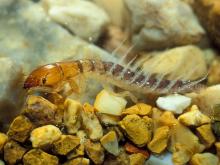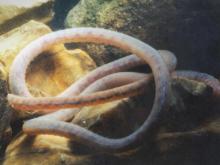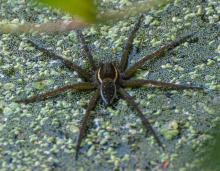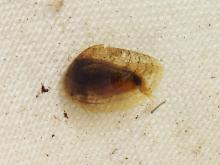Aquatic Invertebrates
Media

Species Types
Scientific Name
Sialis spp.
Description
Alderfly larvae look a lot like their cousins the fishflies, but instead of having pairs of fleshy tails, they have only a single tail pointing straight back.
Media

Species Types
Scientific Name
About 1,500 species in North America north of Mexico
Description
The aquatic larvae of caddisflies are famous for building portable, protective cases out of local materials, including grains of sand, bits of leaves and twigs, and other debris. The adults are mothlike.
Media

Species Types
Scientific Name
Tubifex spp. and other aquatic tubificid annelids
Description
Tubificid worms, as a group, include the tubifex worms that aquarists feed to their pet fish. These segmented worms are related to earthworms and like them are detritus eaters.
Media

Species Types
Scientific Name
Dolomedes spp., Tetragnatha spp., and others
Description
A variety of spiders are adapted for live on and around water. Many of these are called fishing spiders. Several have the ability to run across the water’s surface. Some build webs, others do not.
Media

Species Types
Scientific Name
Dugesia, Planaria, and other genera
Description
Unlike their parasitic cousins in the flatworm group, turbellarians, or planarians, are tiny carnivores or detritus-eaters that glide smoothly across submerged leaves and other objects.
Media

Species Types
Scientific Name
Cyclestherida, Laevicaudata, and Spinicaudata (orders or suborders)
Description
Clam shrimp have their carapace shaped like a pair of clam shells and they can close it tightly when disturbed. But they are not clams: they have tiny, jointed shrimplike legs and bristly, feathery antennae.
Media

Species Types
Scientific Name
Pisidium, Sphaerium, and Musculium spp.
Description
Fingernail clams, also called pill clams or pea clams, are members of a family of small to tiny freshwater clams that are common but rarely noticed. They occur in a variety of aquatic habitats.
Media

Species Types
Scientific Name
Corbicula fluminea
Description
The Asian clam is a nonnative, invasive species that lives in a variety of aquatic habitats. It has thick shells with distinctly ridged, concentric rings and a yellowish-brown to dark brown shell covering.
See Also
About Aquatic Invertebrates in Missouri
Missouri's streams, lakes, and other aquatic habitats hold thousands of kinds of invertebrates — worms, freshwater mussels, snails, crayfish, insects, and other animals without backbones. These creatures are vital links in the aquatic food chain, and their presence and numbers tell us a lot about water quality.





















